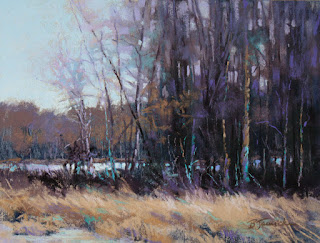 |
| Just Me and the Trees, pastel, 9x12 |
With my first blog post of the new year, I thought I'd try a new look for my blog design. Hope you like it!
Shown above and then at the bottom of this post I've included a few demos from last year's pastel classes. As many of you know, I LOVE teaching! I teach primarily because I enjoy the interaction with other artists and sharing the knowledge that I've learned in my own journey. In my younger years I never thought I'd have an interest in teaching, but now I
can't imagine
not teaching.
I always appreciate the feedback I get from those who take my classes, and I hear many times that students like the fact that I keep my classes very focused on specific topics. This is how I prefer to learn when I take a class from other instructors, so this is how I structure my own classes. This way, when you go into a class or workshop knowing that you should come out of it with some increased knowledge on a particular topic or subject matter, you can better determine afterward if it was worth investing the time and money.
This year I have a busy teaching schedule planned, which includes the continuation of my weekly classes here locally in the Atlanta area (and I've recently added a Tuesday evening class at my studio in Roswell!), but also includes a few more workshops outside my local area...
Weekly Pastel Classes
My weekly classes cover a specific topic or subject matter each week (or for a series of 2-3 weeks).
Spruill Center for the Arts, Dunwoody, GA (www.spruillarts.org)
Monday mornings 10:00 - 1:00 beginning Jan. 7, 2013 for 4 weeks (skips Jan. 21); $100
My classes at this location going forward will likely be either mini sessions (3-4 weeks) or workshops (1-2 days).
Classes at my studio in Roswell, GA
Wednesday & Thursday mornings 10:00 - 1:00
Tuesday evenings 7:00 - 10:00
$35 per class ($25 to view demo only)
I also offer occasional private classes, typically on Friday mornings. (Contact me to inquire.)
Pastel Workshops - "Interpreting the Landscape in Pastel"
My workshops currently take you through specific methods for becoming more interpretive with your landscapes rather than merely copying your reference photos.
Tampa, FL - February 8, 9 &10, Pastel Society of Tampa Bay; $295
New York City - March 15 & 16; Pastel Society of America; $250
Gainesville, GA - March 21 & 22, Quinlan Visual Arts Center; $250
Plans for more workshops in 2013 are pending and may be added to the schedule!
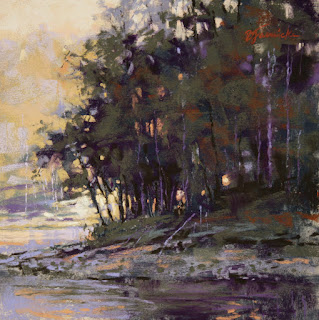 |
| Evening Shade, 8x8 pastel |
Evening Shade and
Just Me and the Trees (at top) are examples of demos in which we worked from black and white photos in order to focus on seeing values more accurately. This exercise also allows you to more easily work with a limited color palette which ultimately enhances the color harmony.
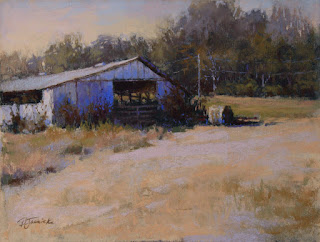 |
| One More Hay Bale, 9x12, pastel |
One More Hay Bale was a paint-along demo for a private class in which we focused on developing a specific limited color palette from the start.
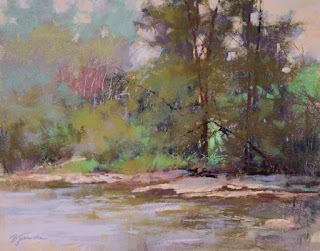 |
| Creekside Glow, 11x14, pastel |
Creekside Glow was from a 2-day workshop. I try to include a few specific topics (but not too many!) in such a short workshop. For this demo, I went through my thumbnail process of simplifying busy subject matter, such as a large area of trees/foliage, focusing mainly on creating 3-4 value groups and using color temperature to move areas forward and backward.
 |
| Afternoon Glow, 8x10, pastel |
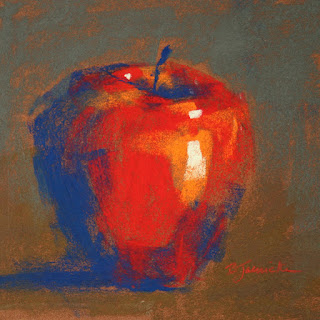 |
| minimal stroke apple study, 6x6, pastel |
Afternoon Glow and the apply study are examples of minimal stroke exercises that my students (and myself!) have found extremely helpful in boosting skill level. In these exercises, we not only count the number of strokes, but also address how to apply each stroke (i.e., how you hold the pastel stick before placing it on the paper, how much pressure to use, etc.).
Other topics I often cover in my classes are edges, underpaintings, approaches to thumbnails, using Photoshop to manipulate reference photos, and various others. But I try to come up with new approaches all the time, so who knows what I'll come up with this year!
See my website at www.barbarajaenicke.com for more details and please feel free to contact me at barbarajaenicke@msn.com if you have any questions about my classes or workshops.































